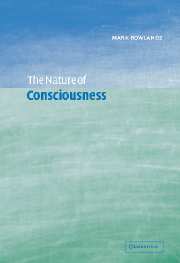Book contents
- Frontmatter
- Contents
- Preface
- 1 The problem of phenomenal consciousness
- 2 Consciousness and supervenience
- 3 The explanatory gap
- 4 Consciousness and higher-order experience
- 5 Consciousness and higher-order thoughts
- 6 The structure of consciousness
- 7 What it is like
- 8 Against objectualism II: mistakes about the way things seem
- 9 Consciousness and representation
- 10 Consciousness and the natural order
- Bibliography
- Index
6 - The structure of consciousness
Published online by Cambridge University Press: 22 September 2009
- Frontmatter
- Contents
- Preface
- 1 The problem of phenomenal consciousness
- 2 Consciousness and supervenience
- 3 The explanatory gap
- 4 Consciousness and higher-order experience
- 5 Consciousness and higher-order thoughts
- 6 The structure of consciousness
- 7 What it is like
- 8 Against objectualism II: mistakes about the way things seem
- 9 Consciousness and representation
- 10 Consciousness and the natural order
- Bibliography
- Index
Summary
Introduction
If we want to understand the peculiar problems consciousness poses for attempts to slot it into the natural order, then we have to understand what is peculiar to, or about, consciousness. In the remainder of the book, I want to press a certain claim, one that, I shall argue, has enormous ramifications. What is peculiar to consciousness is its structure, in particular, its dual structure. Consciousness can be both object and act of experience. Metaphorically speaking, consciousness can be both the directing of awareness and that upon which awareness is directed. Consciousness can include both experiential features of which we are aware, and experiential features with which we are aware. This bifurcation lies at the core of consciousness; consciousness is essentially hybrid, and this, I shall argue, is the basis of its peculiarity.
The hybrid character of consciousness brings with it the possibility of ambiguity in our interpretation of its central features. For example, as we saw in part 1, a conceptual device that has assumed particular importance in explaining the character of consciousness is the notion that there is something that it is like to be conscious, or to undergo conscious experience. However, if consciousness is, indeed, essentially hybrid in character, then this introduces the possibility of quite distinct interpretations of the what it is like of conscious experience.
- Type
- Chapter
- Information
- The Nature of Consciousness , pp. 122 - 147Publisher: Cambridge University PressPrint publication year: 2001



